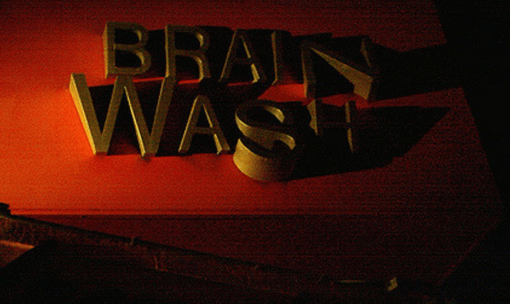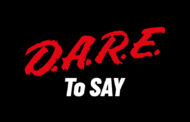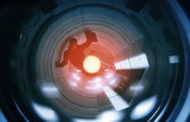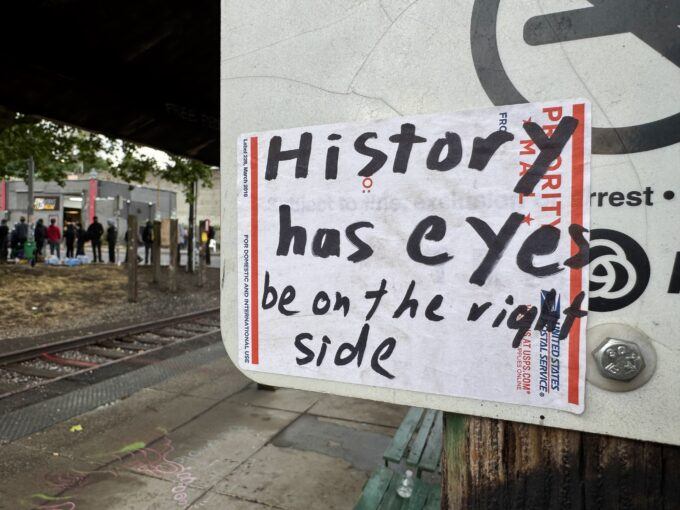
In the Post-Truth Classroom
Published on http://www.counterpunch.org
“It already feels as though we are living in an alternative science-fiction universe where no one agrees on what is true. Just think how much worse it will be when fake news becomes fake video. Democracy assumes that its citizens share the same reality. We’re about to find out whether democracy can be preserved when this assumption no longer holds.”
Henry J. Farrell and Rick Perstein, “Out Hackable Political Future,” The New York Times, February 5, 2018
A Post-truth Corridor to the Classroom
“Post-truth” registers fear in the Heartland, a kind of devolution into a place where “no one agrees on what is true.” It is also a term unconnected with our Western culture paradigm movement from classic realist, Enlightenment modernity, 20th century modernism and postmodernity.
Any variation the word “postmodern” launched attacks from both portside and starboard side thinkers, representing to the former a deconstructing of a rod of critical reason needed to slay the Capitalist monster. For the latter, it represented a deconstructing of absolute and universal foundations of Truth and Reality.
There was, however, no popular and everyday level of representation of the postmodern. Not so with “post-truth” which has a large press online and offline mostly related to the awareness that we can no longer convince each other as to what is really going on, what is really true and what is patently false.
Extending that to the awareness that perhaps we all do not share the same reality does indeed make us think we are in “an alternative science-fiction universe.”
We now have a street level awareness that there doesn’t seem to be any external points of adjudicating reference that are acceptable to those who disagree with you or those disagreeing in Congress or with the President.
There does not seem to be any foundation upon which we can mutually rest our arguments and come to some mutual acceptance of what is true and what is false. Both are frightening epiphanies. What we awkwardly termed “postmodern” simply registered the observation that we have always been without an Archimedean lever that moved us outside the flux of our own disputes, the tyranny of our own opinions.
What has brought us to an almost Kiekegaardian fear and trembling is a street level, around the kitchen table awareness that we have narrated ourselves the existence of fixed stars we could point to that would guide us through and beyond the mis-directions of our own personal compasses.
We have concocted for ourselves universal and absolute foundations that we all recognized and upon which we all stand. And built on this is an edifice of Truth universal and absolute. An awareness that we all don’t stand on such foundations and that indeed such foundations are made variously, here and there, is like a sudden viral invasion of the American mass psyche. This remains a kind of subliminal awareness, one that we are not interpreting or understanding but to which we are reacting nonetheless.
You could say that this is another level of populace awareness beyond what Victorians faced after Darwin published. That broadside against religion, that absolute foundation of faith, which also had its own text, generated fear, and trembling in River City.
What we are broadly aware of now is that our empirical and rational ways of knowing, which survived and indeed flourished when faith was shaken, are no longer sustaining, protective, and paths to civilized agreement.
President Trump shakes us in a number of ways, the least being our failure to put a harness on his antics, the most being our failure to nail down as falsehoods what he announces as truth. What previously was incontestable may now be a matter of dispute, although we do not dispute in any way that allows evidence to defeat personal opinion.
If the President’s mockery of our established ways of knowing had not reached center stage, the practice of spinning reality into a hyperreality, which marketers and politicians have long done would have continued quite nicely alongside the mythologies of unquestionable truth discoveries made in a reality that never multi-plexes because true narratives never multi-plex.
The cat is out of the bag, although he is now in Schrodinger’s box, by which I only mean that we can no longer know in any indisputable way what is going on, has gone on, or will go on.
Any grasp of this dilemma is compounded by the swerve a “post-truth” attitude makes on the postmodern bottomless chess board. This is a swerve away from the postmodern observation that an inescapable mediation occurs between consciousness and a “Great Outdoors” it is always already within.
In short, we do not construct reality independent of any relationship with a world “out there.” Observing that we humans live within what we so fabricate and then narrate does not lead us to the conclusion that reality is what we say it is and truth lies where we see it. We fabricate but the world is in no way bound to comply.
What we have now in our post-truth clime is a strange variant of subjective idealism, a kind of bottom rung spot where we do not argue that what we see is what we ourselves create. We simply argue that what we opine regarding anything is what is real to us, regardless of what others argue as real. Thus, we no longer really argue, argument now preempted by an a priori of personal knowing.
The ensuing collapse into narcissism and its pathological extreme, solipsism, a collapse that is comparable to an opiod epidemic, is fearful and not postmodern but post-truth.
We are frighteningly post-knowing the world in any way beyond our own knowing, which can never expand but remains entrapped. We each know others who are so entrapped by their own way of knowing and what they thus hold as known.
In the post-truth clime, we now seem to be without any windows or doors through and by which we could lead others or ourselves out. Perhaps it was always a presumption to believe that we could do so, that with enough of the right kind of education, we could enlighten minds darkened by nonsense and myths, irrationalities of all kinds, self-concocted lunacies and fallacies, conclusions found that have no rhyme or reason.
We thought we could all look at a photo or a video of a crowd and see that not hundreds of millions are there but only thousands. And we thought we could easily correct and convince anyone who disagreed.
This is a long stretch of corridor but a quite necessary background sketch to a discussion of the classroom of the future, that future actually appearing rapidly before our eyes.
How is anyone teachable in a post-truth world? What can be taught? Beyond these pedagogical interests lies the matter of how anyone learns anything beyond the tyranny of one’s own opinion in a post-truth world?
It is clear that President Trump stopped learning anything beyond the boundaries of well established opinions, perhaps established at an early age. He’s not alone of course but as he consumes the public space, sucks up all the oxygen in the American persona, his imprisonment in his own small mental cell and our inability to avoid being pulled into it rather than pulling him out is a manifestation of our post-truth dilemma staring us in the face.
A Classroom
“If education is equated almost solely with job training rather than a broader critical citizenship agenda for participatory democracy, we can expect the further decline of social democracy and the rise of populist demagogue politicians and alt-right racist parties. In the era of post-truth it is not enough to revisit notions or theories of truth, accounts of ‘evidence,’ and forms of epistemic justification as a guide to truth, but we need to understand the broader epistemological and Orwellian implications of post-truth politics, science and education.”
Michael A. Peters, “Education in a Post-Truth World,” Educational Philosophy and Theory, 2017
“Because computing is going mobile and over the next decade we’re going to see the full fury of individualized computing via handhelds come to the fore. Can’t wait.”
— Tina Barseghian, “21 Things That Will Be Obsolete by 2020,” Mind/Shift, 2011
We now know that “social media was the primary outlet for the circulation of fake news stories” and that voting patterns “strongly correlated with the average daily fraction of users visiting websites serving fake news.” (Eric Alterman, “The News Is Breaking,” The Nation, February 26, 2018)
If social media is a preferred medium of knowing anything and that medium pitches what is always more attractive to the “lizard brain” then educating toward rational review and empirical validation rises to a level previously unknown to us.
What has happened is that the spinning machine of marketing, branding and advertising has extended beyond products and services and entered a previously guarded domain of fact and evidence, rational argument and justified conclusions. And it has done this simply by transferring its hucksterism to social media platforms that now own the public discourse space.
And the classroom is one of those spaces, as is of course, politics, which also now bends to the strategies of hucksterism, celebrity branding, and appeals to the “lizard brain.” But the future rests on how well minds are developed now; the quality of our future politicians depends upon the quality of education the young are receiving now.
Whether Google Classroom and other invasions of cybertech into education expand the development of critical minds or contract those minds into what spaces cybertech creates for us and by doing so expands its own development, measured in profit to shareholders, must await a future question to Google or its heirs.
Whether the prioritizing of vouchers and for-profit charter schools and less funding for public education, which is Secretary Betsy DeVos’s plan, expands the development of critical minds is a future matter.
Here is a matter — the future — which allows us to see how a postmodern conception of being and knowing is of another order than a post-truth entry in a diagnostic manual of the American mass psyche.
In a postmodern view, a future reality of American education may be what both technology and for-profit education create. In our hypothetical manual, fear and paranoia generated by the hyperreal would be the diagnosis.
Post-truth would be described as a numbing fear of a world in which “no one can agree on what is true” though we are barraged steadily with tweets of truth. A search for meaning is at once waylaid by nonsense that goes viral as sense. In every way, the real is displaced by simulacra.
The way out of this chaos in the real world is unfortunately is now mapped within cyberspace by cybertech. In every fearful situation, technology is to be applied, although it should seem clear to us by now that we are exacerbating such a chaos of hyperreality and thus distancing ourselves from conditions “on the ground.”
A post-truth diagnosis means we are both fearful and frozen in place and at the same time reaching for what is driving us deeper into both states.
An individual learner positioned anywhere and free to choose with a mobile device in hand or inserted in the frontal lobe seems to be our light in the tunnel. This obviously is not a society but condition of mass solipsism and a state of fear and trembling where “no one can agree on what is true.”
In a postmodern view, if the education we are now pursuing enters the future that education would exist without an alternative or comparative perspective. Such a perspective would enable us to see outside what technology and for-profit education have conspired as “real.” Without such a perspective, we would in effect be enclosing ourselves within a reality framed by technology and profit.
We can foresee that a current move from printed to digital, the uselessness of teaching cursive writing, the low ground of twitter “debate,” all the news via video, the dismissal of a pre-digital history, and the collapse of reading beyond one Smartphone page (“Books were nice. In ten years’ time, all reading will be via digital means.” Mind/Shift) will require a commensurate level of grading and scoring.
We cannot expect that a profit making enterprise will allow a bad grade result. “The SAT isn’t far behind [in extinction] Over the next ten years, we will see Digital Portfolios replace test scores as the #1 factor in college admissions.” (Mind-Shift)
Whether one reads on papyrus, hand set printed pages or a Smartphone screen does not matter, except for the papyrus or book collector. What matters is a sustained attentiveness that can pursue an exposition, interpret meaning, place that meaning within an historical comparative context and build an edifice of understanding in the mind to be applied to what is read next.
Our cyberspace storehouse presents both reason and irrationality, sense and nonsense, spins of the hyperreal and closely argued expositions, although these are often from anonymous sources. Autodidacts with issues and baggage now attract more eyeballs than credentialed authorities. Celebrity charlatans attract enough votes to win the presidency.
Retrieval of this cyberspace storehouse is also left to personal choice, to the discretions of those in need of a compass of understanding that would enable choices that go outside the vicious circle of one’s preferences and peccadilloes.
In short, we can only intelligently search in cyberspace if we are already in possession of that for which we search. Google Classroom, for example, is grounded in this assumption, one that actually replaces the complexities of learning with tech toys everyone, especially the young, love to play with.
We already observe certain complicity between cybertech in the classroom and for-profit education, perhaps because it creates very advantageous profit conditions. The presence and value of teachers are minimized, thus minimizing labor costs as well as vacating teachers’ unions. “In ten years, the teacher who hasn’t yet figured out how to use tech to personalize learning will be the teacher out of a job.” (Mind/Shift)
Students also become lifelong consumers of every new generation of cybertech products as their way of knowing becomes shaped by how that knowing is technologically shaped.
There is the added benefit of placing a student in a personal relationship with a machine, a kind of self-authorizing, self-guided tutorial, one in which their own preferences and priorities displace learning in common with others. “Education over the next ten years will become more individualized, leaving the bulk of grade-based learning in the past.” (Mind-Shift)
This is very much in line with a post-truth rejection of any common apprehension of truth and a turn therefore to a personal determination and to personal ways of reaching that determination.
There are no professional arbiters of truth in a post-truth climate, just as there are no professional journalists or professional critics of any sort, or any courtroom judges not adjudicating by personal prejudice, or any scientists who know more than what you can see for yourself, or any media that is not making up stories presuming to be truer than your own, or any politicians who have no authority to legislate for you.
President Trump is an exception in the minds of some not because of a respect for his authority but because he, like them, lashes/tweets out against all authority. As long as he does this, which is patently absurd for the political leader of the country, he has followers. The confusion and near chaos we now see in government is a result of our president attempting to upend what he has been elected to protect and serve.
Situated thusly in a post-truth world we each turn to our Smartphones.
We are the masters of this domain. Americans collectively check their cell phones 8 billion times a day, and on the average, each of us does so 2,617 times a day, at least according to the research firm Dscout, an authority in a world that recognizes no authority but one’s own. 97% of scientists believe in anthropocene global warming though 51% of Americans deny this or conclude there is not enough evidence in this world.
So, a classroom in a post-truth environment is one in which students have total respect for their own self-determinations and no respect for any authority outside those self-determinations.
This is a bald assertion that seems easily refutable. Aren’t students via cybertech put into contacts with more voices outside their own than books, blackboards, and teachers ever could summon?
Wandering/surfing around cyberspace according to your own mental mapping does not pose dangers for an educated mind, one that can detour around the dark pits of pure crazy, degeneracy and clever brainwashing cyberspace offers. Not so if that journeying mind has no defenses. What kind of Virgilian guidance can be given in a post-truth classroom when your student is already tied to his or her own personal choices and is not at all willing to accept any authority you might seem to be imposing? “Get over yourself,” our Mind/Shift author advises teachers presuming to counter personal opinion.
And yet there are ways we can create a learning atmosphere in the post-truth classroom in which all are learning in common. And I believe it can be done if we arrest the fears of what we call a post-truth invasion of the American mass psyche. We can return to a mediation of our own consciousness and a reality distinguishable from the hyperreal our cybertech axiomatically generates.












